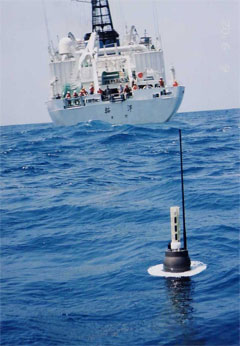Arctic ocean warms as global oceans cool
Arctic ocean warms as global oceans cool
mongabay.com
September 26, 2006
Scientists at the University of Alaska Fairbanks International Arctic Research Center say that warm water from the North Atlantic Ocean continues to surge into the Arctic Ocean potentially increasing ice melt in the region.
During an oceanographic expedition aboard the Russian icebreaker Kapitan Dranitsyn this fall, researchers found unprecedented warmth in some parts of the Arctic Ocean.
“The large area of the Arctic Ocean promises to become much warmer,” said Igor Polyakov, a research professor at the University of Alaska Fairbanks International Arctic Research Center and principal investigator of the Nansen and Amundsen Basins Observational Systems (NABOS) program.
Using observational moorings — floating instruments anchored to the ocean floor — the researchers detected a surge of “anomalous warm water” into the Arctic and towards Alaska and the Canadian Basin, a change that could have global significance.
 An Argo float shortly before recovery by the Japan Coast Guard vessel Takuyo. Image credit: Japan Coast Guard Greenland’s ice continues to melt. Data gathered by a pair of NASA satellites orbiting Earth show Greenland continued to lose ice mass at a significant rate through April 2006, and that the rate of loss is accelerating, according to a new University of Colorado at Boulder study. Arctic ice hole larger than Britain forms, shocks scientists. European Space Agency satellite images acquired from 23 to 25 August 2006 have shown for the first time dramatic openings larger than the size of the British Isles in the Arctic’s perennial sea ice pack north of Svalbard, and extending into the Russian Arctic all the way to the North Pole. The agency says the findings are shocking to scientists. ‘If this anomaly trend continues, the North-East Passage or ‘Northern Sea Route’ between Europe and Asia will be open over longer intervals of time, and it is conceivable we might see attempts at sailing around the world directly across the summer Arctic Ocean within the next 10-20 years,’ said Mark Drinkwater, a scientist with ESA. Arctic ice melting rapidly, polar bears suffering – new research. New research shows that Arctic sea ice is rapidly disappearing. Scientists say that the human-induced buildup of greenhouse gases in the atmosphere is a leading culprit behind the decline. North Atlantic Ocean freshening could weaken Gulf Stream. A new analysis of 50 years of changes in freshwater inputs to the Arctic Ocean and North Atlantic may help shed light on what’apos;s behind the recently observed freshening of the North Atlantic Ocean. In a report, published in the August 25, 2006 issue of the journal, Science, MBL (Marine Biological Laboratory) senior scientist Bruce J. Peterson and his colleagues describe a first-of-its-kind effort to create a big-picture view of hydrologic trends in the Arctic. Their analysis reveals that freshwater increases from Arctic Ocean sources appear to be highly linked to a fresher North Atlantic. |
“Ocean temperature in the Arctic is important because it may affect the amount of sea ice in the region,” explained Marmian Grimes, a writer at the University of Alaska Fairbanks. “Scientists believe that arctic sea ice cover plays a major role in the global climate, as ice reflects more of the sun’s heat than open water.”
While the Alaska researchers found warmer temperatures in the Arctic, NASA scientists reported an average drop in surface temperatures since 2003 — though the decline is a fraction of the total ocean warming over the previous five decades. NASA says the study, published in the journal Geophysical Research Letters, “suggests global warming trends are not always steady in their effects on ocean temperatures.”
“This research suggests global warming isn’t always steady, but happens with occasional ‘speed bumps’,” said Dr. Josh Willis, a co-author of the study at NASA’s Jet Propulsion Laboratory. “This cooling is probably natural climate variability. The oceans today are still warmer than they were during the 1980s, and most scientists expect the oceans will eventually continue to warm in response to human-induced climate change.”
The study, which “estimated the heat content of the upper 750 meters (approximately 2,500 feet) of Earth’s oceans from 1993 to 2005” using data from satellites, ocean moorings, floats and shipboard sensors, found the average temperature of the upper ocean increased by 0.09 degrees Celsius (0.16 degrees Fahrenheit) from 1993 to 2003, and then fell 0.03 degrees Celsius (0.055 degrees Fahrenheit) from 2003 to 2005. However, the recent decrease only represents about one-fifth of the temperature gain by the ocean between 1955 and 2003.
Dr. John Lyman, a scientist at the National Oceanic and Atmospheric Administration (NOAA) Pacific Marine Environmental Laboratory in Seattle and co-author of the study, said the recent temperature drop is not without precedent.
“While global ocean temperatures have generally increased over the past 50 years, there have also been substantial decadal decreases,” Lyman said. “Other studies have shown that a similar rapid cooling took place from 1980 to 1983. But overall, the long-term trend is warming.”
Lyman further added that understanding changes in heat content of oceans is “vital to understanding how Earth’s energy balance is changing.”
“The capacity of Earth’s oceans to store the sun’s energy is more than 1,000 times that of Earth’s atmosphere,” he explained. “It’s important to measure upper ocean temperature, since 84 percent of the heat absorbed by Earth since the mid-1950s has gone toward warming the ocean. Measuring ocean temperature is really measuring the progress of global warming… Understanding decadal rises and dips in Earth’s ocean temperature is important in predicting Earth’s climate. Hopefully, the results of our study will help refine the ability of computer models to make these predictions”
This article is based on news releases from the University of Alaska Fairbanks and NASA.